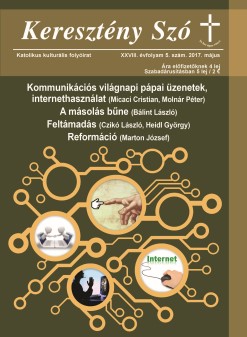
We kindly inform you that, as long as the subject affiliation of our 300.000+ articles is in progress, you might get unsufficient or no results on your third level or second level search. In this case, please broaden your search criteria.
















In this article the author presents certain aspects of pastoral work with youth, describing young people’s reality and the dynamic of pastoral work in Latin America, as well as certain aspects of pastoral work with youth for an “outward-reaching” Church. Criteria are indicated for the pastoral accompaniment of Latin American young people today, from a model of Church which Pope Francis has denominated “outward-reaching” (or “going forth”). This model challenges us to rethink pastoral work with youth, situating it in the horizon of the path of pastoral action in the perspective of Aparecida, which allows us to “deeply rethink and relaunch [the Church’s] mission in current Latin American and global circumstances with fidelity and audacity” (DA 11). This requires that the Church show its readiness to appreciate, value and encourage pastoral initiatives and processes that are developing “outside” of explicit parochial spheres, so as to immerse itself in the missionary adventure towards and into spaces where young people are on the margins. Without doubt this means reconsidering the forms in which parochial and wider ecclesial life is organized. This challenge implies leaving behind pre-designed blueprints in order to meet young people there where they are, in the majority of cases outside the Church, adapting to their times and rhythms. This paper presents four nuclear problems posed by CELAM (Latin American Episcopal Council) for 2015-2019 (social injustice, the deterioration of creation, violence and migration), which question the Church in its evangelizing task and open a challenging panorama for an “outward reaching” pastoral work with youth. Missionary activity which takes these four nuclear problems seriously lets arise a “new subject who emerges in history and which we call disciple” (DA 243), an active member of the Church and a citizen capable of making a significant contribution to society. It becomes obvious that pastoral work with youth in the service of the spreading the Good News isn’t under discussion, but rather is launched with the aim that the light of Christ shine on the faces of the poor and the reality of our peoples. A new model opens up for an “outward reaching” pastoral work with youth, centred in the following of Christ and at the service of life, that is to say with greater impact on society.
More...

Priests who, for whatever reason, have ceased their priestly service, present after some time their view of the Church, their experience with studies, and the description of the reasons of termination of their service. A study mapping the views of a group of such respondents seeks to identify topics that are relevant for further development of the work of the Church. The most important outcomes are the need to improve the theological formation of priesthood candidates, to practice priestly skills necessary for pastoral care, and to improve communication within the Church structure.
More...
Artykuł jest głosem w dyskusji nad jakością wykorzystywania mediów w ewangelizacji przez duchowieństwo, osoby świeckie. Jego celem jest wykazanie potrzeby ciągłego powrotu do wskazań Soboru Watykańskiego II w dokumencie Inter mirifica o współczesnych formach przekazu. W pierwszej części zostało syntetycznie i aspektowo przedstawione znaczenie słowa ewangelizacji, z której wynika, że obok ustnego i pisemnego głoszenia, Kościół powinien być otwarty na używanie do tego celu nowych technologii. Druga część jest zarysem historii Kościoła w kontekście środków społecznego przekazu. Z prze-prowadzonych analiz zostały wyprowadzone wnioski, z których wynika, że Kościół roz-tropnie odkrywał funkcje i znaczenie nowych technologii i pragnie je wykorzystać w głoszeniu Ewangelii. W ostatniej części zaprezentowano konkretne odniesienie dokumentu soborowego Inter mirifica do posługi duchownych, świeckich w przekazie Dobrej Nowiny za pomocą nowych technologii.
More...
Kościół katolicki prowadzi działalność ewangelizacyjną, która ma wymiar globalny, gdyż dociera do wszystkich państw i narodów na świecie. Aktywność Kościoła posiada charakter nie tylko religijny, ale również społeczny, ponieważ jest ukierunkowana na człowieka żyjącego w społeczeństwie. Człowiek jest drogą Kościoła. Dlatego też nadrzędnym celem działalności Kościoła jest pomaganie człowiekowi w osiągnięciu zbawienia. Człowiek dąży do zbawienia, żyjąc w świecie i wykonując swoje codzienne obowiązki. Poprzez pracę ulepsza życie społeczne i udoskonala siebie. W swoim nauczaniu Kościół ukazuje wszystkim ludziom, a zwłaszcza wyznawcom Chrystusa najważniejsze kierunki ich aktywności religijno-społecznej oraz zachęca do wysiłku w celu udoskonalania społeczeństwa, w którym żyją. Kościół nie tylko podkreśla wartość ludzkiej pracy na rzecz dobra wspólnego społeczeństwa, ale sam angażuje się w liczne przedsięwzięcia mające na celu udoskonalenie rzeczywistości doczesnej i polepszenie warunków życia ludzkiego. Najbardziej rozpoznawalną formą aktywności instytucji kościelnych jest niesienie pomocy ubogim, chorym i cierpiącym. Aktywność religijno-społeczna Kościoła uczy solidarności międzyludzkiej oraz buduje wspólnotę, wzmacniając więzi społeczne i zbliżając ludzi do siebie.
More...